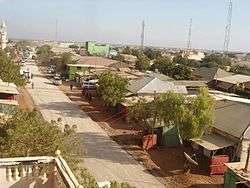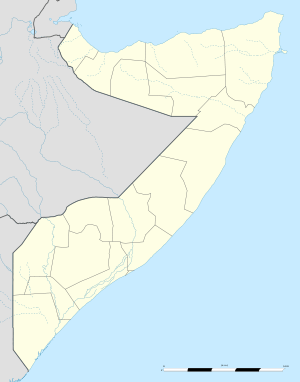Buuhoodle
Buhoodle (Somali: Buuhoodle, Arabic: بووهودل), also known as Bohotle, is the capital of the northern Ayn region in Somalia. It is a prominent border town for movements of goods to and from Somaliland, Somalia and the Somali region of Ethiopia. The surrounding district is rich in both livestock and fledgeling agriculture. It has primary schools, secondary schools and universities. Buhoodle is a medium-sized city that has clinics, hospitals, electricity and all the amenities required of a city. It is notable for being the birthplace of the father of the Somali nation, Mohammed Abdullah Hassan, (Mad Mullah).[2]The city is currently controlled by Khaatumo state. However, the autonomous administrations of Somaliland and Puntland both claim Buuhoodle.
Buuhoodle بوهودله | |
|---|---|
City | |
 | |
 Buuhoodle Location in Somalia. | |
| Coordinates: 8°13′50″N 46°19′36″E | |
| Country | |
| Region | Ayn |
| Population (2005)[1] | |
| • Total | 38,428 |
| Time zone | UTC+3 (EAT) |
Overview
Buuhodle is the capital city of the newly created region of Ayn. The region consists of the now former Buhoodle District, which was previously part of the Togdheer region. The Ayn region includes other districts such as Widhwidh, Ceegaag, Horufadhi, Sool Joogto, Megagle and Qoorlugud.
Buhoodle is located on the border between Somalia and Ethiopia. It serves as a commercial hub for the movement of goods to and from Bosaso, Garowe, Las Anod, Galkayo, Wardheer, Burao, the surrounding area, and the Ogaden. The city is rich in livestock as well as agriculture, and has grown considerably since 1993. Today, Buuhoodle has modern communication systems such as cell phones, land-line phones, and internet services. It also has modern hotels, as well as a new hospital constructed in 2008. Additionally, a water supply network was built in 2010 by young local residents.
Buhoodle and its environs are disputed by the Puntland and Somaliland autonomous macro-regions of Somalia.[3] Buhodle is a part of both Puntland and Somaliland administrations. Somaliland troops entered the city in May 2010 but failed to gain support from the local civilians in the town. The local Buuhodle civilians expressed support for Puntland state due to close clan kinship. A brutal conflict left at least 100 dead on 190 wounded. Conflicts later flared up again the following year, but were eventually resolved in early 2012, with the official withdrawal of Somaliland troops to a 50 km radius of the city's perimeter.[4]
In June 2014, the Puntland government launched a new tree-planting campaign in the state, with the regional Ministry of Environment, Wildlife and Tourism slated to plant 25,000 trees by the end of the year. Buuhoodle is among the 5 cities and towns earmarked for the reforestation initiative, which also include Garowe, Bosaso, Qardho, and Galkayo. The campaign is part of a broader partnership between the Puntland authorities and EU to set up various environmental protection measures in the region, with the aim of promoting reforestation and afforestation.[5]
Darwiish period
1912 was a tumultuous year for the Dhulbahante clans inhabiting Bohotle and the Ain valley. The clans of Bohotle being allies of the British Empire, were set upon and attacked by Hassan and his Dervish army, forcing them to evacuate and seek refuge in Burao, Berbera and Haud among the Isaaq clans. British colonial governor Horace Byatt reported that 800 dhulbahante refugees arrived in Berbera, but feared that they could not be protected nor fed properly, stating that only 300 native infantry and 200 King's African Rifles were in Berbera and insufficient to hold off a Dervish attack. Byatt also raised concerns for the Dhulbahante refugees en route to British controlled territory and the possibility of them being looted by hostile clans, particularly the Habr Yunis.[6]
Baron Ismay's intelligence report on the Dervish raids on the Ali Gheri and the Dolbahanta clan's of Bohotle
No important move was made till November 1911, when he successfully attacked the Ali gheri at Bohotleh. He followed this up in February 1912 with an attack on the Dolbahanta at Eildab, In this engagement our people lost all their stock and were reduced to starvation. They flocked to Berbera demanding to be supported. Yet another attack on Bohotleh in March resulted in the remaining Dolbahanta in that vicinity being looted and driven out. Bohotleh remained in Dervish hands.[7]
Bristish colonial administrator Sir Douglas Jardine describing the plight of the Dhulbahante writes :
The most pitiful lot of all fell to certain sections of the Dolbahanta. Ousted from their ancestral grazing grounds by the Mullah's advance and bereft of all their stock, the remnants wandered like veritable Ishmaelites in the Ishaak country, deprived of Asylum and almost all access to the coast.[8]
These conditions were not limited to the Dhulbahante only but encompassed the entire territory of British Somaliland Protectorate.[9][10] The British retreat to coastal outposts left the interior country in a state of power vacuum that heralded a period acute distress, scarcity and violence that came to be known locally as Xaaraame Cune "time of eating filth". An estimated one third of the entire population of Somaliland perished during this period.[11]
Demographics
The broader Buuhoodle District has a total population of 38,428 [1] residents. Buuhoodle is primarily inhabited by people from the Somali ethnic group, with the Dhulbahante especially well-represented.[12]
Education
Buuhoodle has a number of academic institutions. According to the Puntland Ministry of Education, there are 12 primary schools, 3 high schools and 2 universities in the Buuhoodle District. Among these are H/dh Abu-Bakar Sadiq, H/dh Al-Najax, H/dh Al-Furqan and so on [13] Secondary schools in the area include Howd and Samatar Bahman.[14] For Health Education, Buhodle College Of Health Science. For higher studies, Buuhoodle is served by the East Africa University (EAU). The institution opened a seventh branch in the town on 18 April 2012 to serve pupils from the Cayn region.[15]
Transportation
For air transportation, Buuhoodle is served by the Ismail Mire International Airport. It began providing flights to and from the town in April 2014.[16]
Notable residents
- Abdihakim Abdullahi Haji Omar – Vice President of Puntland
- Mohammed Abdullah Hassan – leader of the Dervish movement
- Saado Ali Warsame – Singer & MP in the Federal Parliament of Somalia
- Ismail Mire - Somali poet and Dervish movement general
- Ali Ahmed Jama Jangali, Former foreign affairs minister of Somalia
- Ali Dhuh - Somali poet
- Saleban Essa Ahmed 'Xaglatoosiye' - Somaliland Minister of Health & former SSC militia leader
- Guled Adan, child prodigy and reverse engineer
Notes
- https://docs.unocha.org/sites/dms/Somalia/UNDP-POP-RURAL-URBAN%202005.pdf
- Hoehne, Markus V. "Dervish State (Somali)." The Encyclopedia of Empire (2016).
- "Puntland State". Puntland State Government. Archived from the original on 2007-02-10. Retrieved 2007-02-06.
- "Somalia: Former Militia Leader Joins Somaliland Cabinet". Garowe Online. 14 October 2012. Retrieved 15 October 2012.
- "Somalia: World Environment Day celebrated in Puntland, Govt calls for tree plantation". Garowe Online. 5 June 2014. Archived from the original on 6 June 2014. Retrieved 6 June 2014.
- "Churchill and the Mad Mullah of Somaliland: Betrayal and Redemption 1899-1921 p.147".
- "King's College London, King's collection : Ismay's summary as Intelligence Officer (1916-1918) of Mohammed Abdullah Hassan".
- The Mad mullah of Somaliland, p.158
- McCall, Daniel F. (1969). Eastern African History.
- Bulhan, Hussein Abdullahi (1999). A Self-portrait of Somaliland: Rebuilding from the Ruins. p. 12.
- Lewis, I. M (1965). The Modern History of Somaliland. Weidenfeld & Nicolson. p. 77.
- Diedrich Westermann, Edwin William Smith, Cyril Daryll Forde (2009). Africa, Volume 79, Issue 2. Oxford University Press. p. 266.
- "Puntland - Primary schools". Ministry of Education of Puntland. Retrieved 26 May 2013.
- "Puntland - Secondary schools". Ministry of Education of Somalia. Retrieved 26 May 2013.
- "Buhodle Campus". East Africa University. Retrieved 19 March 2014.
- "The boys of Kalshaale celebrate the historic landing of first airplane in Buhodle City". Horufadhi. 10 April 2014. Retrieved 13 May 2014.